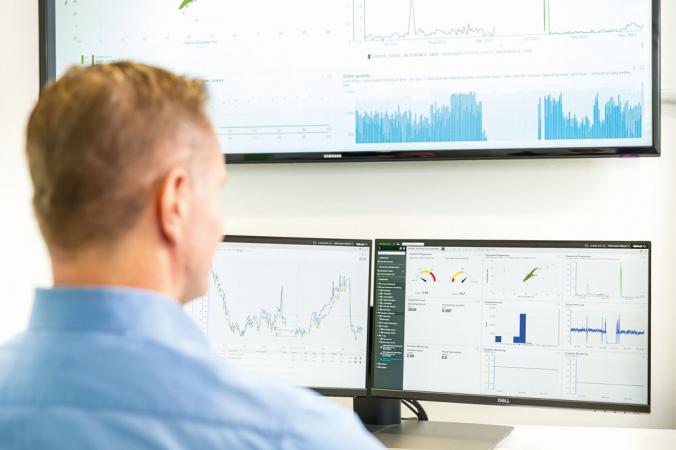From Data to Decisions and Improved business
In order to succeed, Industrial Internet of Things (IIoT) solutions need several technological layers. More
importantly, IIoT needs to be closely knit to the actual business needs. Only then can new technologies
improve company business.
There are four important technological layers which constitute the concept of Industrial Internet of Things: (1) Sensors that collect data from products and operations, (2) reliable, real-time data transmission, (3) data warehouse, which combines data from multiple sources, and (4) analytics that refines data into meaningful information for decision support. When these layers are working seamlessly, it is possible to build new digital services and business models on top of them, which enhance old ways of working and take them to the next level.
In the past few decades, technological advancements related to sensors, data transmission, warehousing, and analytics have been profound. Modern products and services can produce various kinds of data from themselves and their surroundings, which through the IIoT pipeline end up as meaningful information for the use of decision support in near real-time.
Due to technological advancements, the concept of IIoT is more than the sum of its parts. Meaningful information is available more reliably, comprehensively, and systematically than ever before and at the right time for the actual need. This is what IIoT is all about.
IIoT in itself does not make company success. Instead, it enables companies to increase productivity and create new business. The new technology concept challenges companies to renew traditional ways of working and doing business. However, the fundamentals of conducting business do not change. It is still crucial to work on defining the essential questions related to pain points of business and areas of development. Many areas benefit from real-time meaningful information and that is why IIoT can be taken advantage of in a variety of ways in companies.
Concrete Benefits of IIoT
Companies can improve their operations through better utilization of their own data. IIoT can help companies to utilize data at least in five different approaches. First, collecting and combining data from various sources and refining it into meaningful information leads to a better understanding of the big picture. It is important to know exactly what is happening in company operations and how different factors and phenomena have an impact on each other. Due to the constrained nature of human perception, it is beneficial to use IIoT related tools such as advanced analytics to see the big picture.
Second, one of the key characteristics of IIoT, automating the refinement of data, brings more speed and accuracy during e.g. troubleshooting in manufacturing. Certain routine tasks such as gathering data from several sources and testing of hypotheses can be automated. This way, experts can focus more on making decisions based on refined data instead of spending time on doing the actual data refinement.
The third approach in utilizing data is proactive operations. Real-time collection and analysis of data enables companies to better predict and prevent e.g. quality defects and unplanned production stoppages. With IIoT a company can take a significant leap from reactive operations into proactive ways of working. Preventative maintenance, especially, benefits considerably from new information and multivariable predictions brought by IIoT.
Fourth, data can also be utilized in order to better understand customer behaviour, which can ultimately lead to increased revenue. When machine manufacturers know exactly, how their customers are using their machines, it is possible to offer e.g. maintenance services with better quality than what customers could do by themselves. In addition to machine hours, many other factors affect the timing of the next service break, such as how the machine has been operated and in what conditions. More comprehensive information about machines and their environment leads to better business opportunities for machine manufacturers.
Finally, the fifth way to utilize data is related to organizations’ tacit knowledge and its transformation from individual employees’ minds into the knowledge of the whole organization. In a company, employees from different backgrounds and of varying experience work in the same tasks such as operating a production line in multiple shifts. Employees might adjust production, based on their subjective perception of what should be done. With the help of IIoT, data from the production line can be refined into objective information to support decisions made by operators and in a way, standardize operations throughout the organization.
How to get started?
Accurate and meaningful on-time information is one of the most important things in enabling successful business. Industrial Internet of Things is, no more and no less, a technology concept, which makes this type of information available better than ever before. However, valuable information for someone might be useless information for others. Therefore, it is every company’s and their customers’ own needs, challenges, and goals that need to be at the centre of any IIoT solutions. Only this way, IIoT can bring a company valuable information and hence improve business.
Case Zellstoff Pöls AG
Condition monitoring through IIoT
Seppo Silenius, ANDRITZ OY , seppo.silenius@andritz.com
ANDRITZ Oy’s Wood Processing and Service units deliver wood, wood chips, bark and biomass processing technologies and services to the pulp and power plant industries. In the pulp mill’s wood room, chippers cut wood into chips for cooking pulp.
ChipperEKG real-time operation and condition monitoring of chippers ensures high availability and chip quality and provides key figures for the wood room’s operating and condition-monitoring personnel, as well as the supplier’s various interest groups.
Advanced analytics while running the chipper makes it possible to find out, for example, if one of the chipper knives is damaged. The amount of data received from the sensors is so large that the key figures relating to condition and operation are calculated immediately when the data is read.
It is important to inform the operator immediately of knife breakage or a badly mounted knife, so that the chipper can be stopped. Detecting faults in time can prevent expensive damage.
For the process and equipment supplier, the availability of key figures of the equipment is essential. Consequently, technical support can make use of real-time data, and the current operation of the equipment can also be compared with planned operation.
Case LKAB
Energy efficiency through IIoT
Jukka Kostiainen, ABB Oy , jukka.kostiainen@fi.abb.com
In 2012 EU’s biggest iron ore manufacturer and ABB, a global leader in power and automation, decided to join forces to improve LKAB’s energy efficiency.
LKAB initiated an ambitious project in 2011 to improve energy efficiency by 20 percent by 2020. ABB’s cpmPlus Energy Monitoring and Targeting energy management system was commissioned in 2012 and has proven to be a key element in managing the process.
The system collects and reports data collected from more than 1200 measurements from three locations and 12 facilities. In addition, data is collected from real estate and transportation. The system covers the energy measurement and reporting requirements set by the ISO 50001 standard.
The reporting and analytics functionalities give LKAB in real time, a holistic view of the actual energy efficiency compared to targets and actual achievable potential. Problem areas needing attention are quickly detected and prioritized. The effects of corrective actions are easy to follow and monitor.










